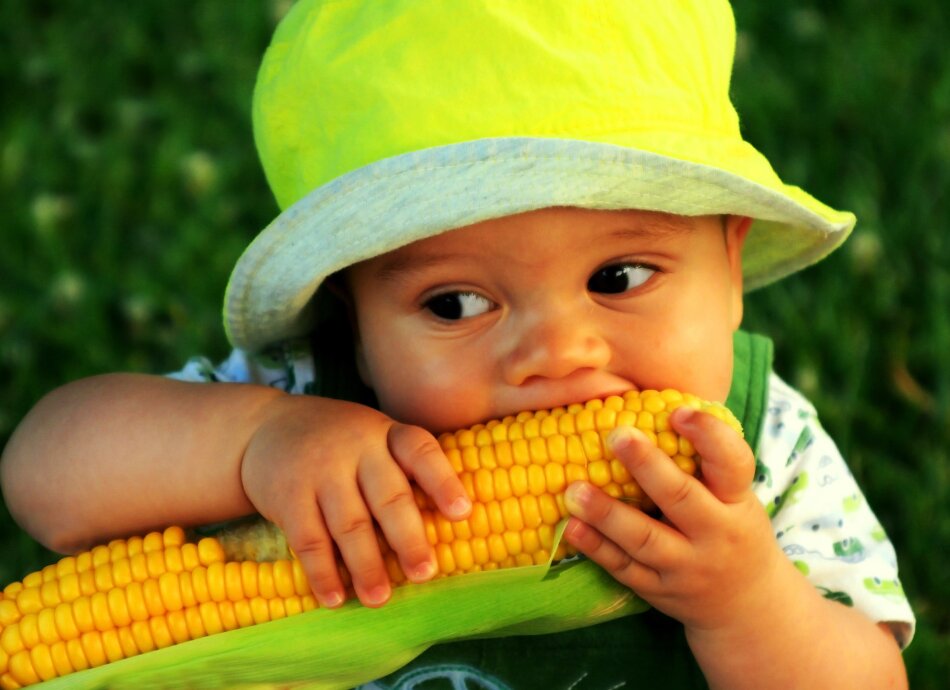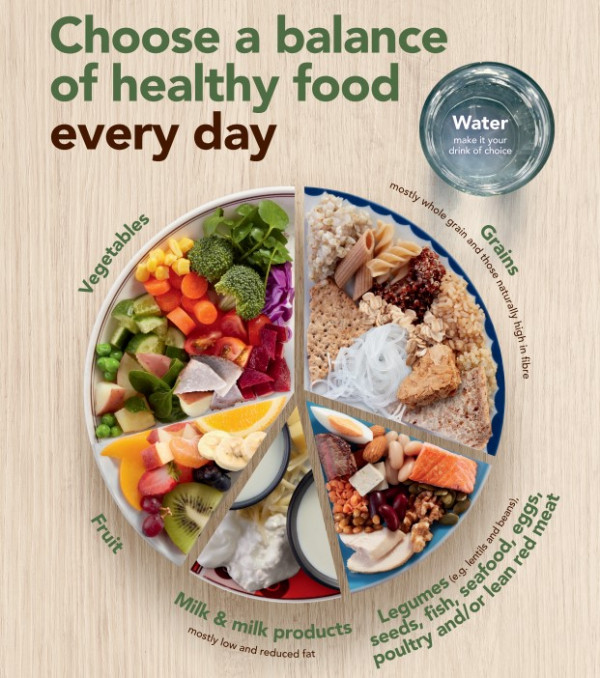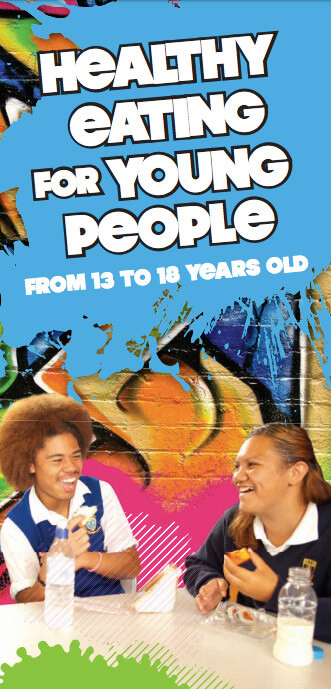Wishing everyone a safe and happy Christmas and New Year – Meri Kirihimete from the Healthify team.
Food groups and serving size – children
Key points about food groups and serving sizes for children
- Eating a variety of foods each day helps children get all the essential nutrients needed to support wellbeing, growth and development.
- A healthy eating pattern includes food from all 4 food groups including vegetables and fruit, grain foods, milk and milk products, and protein foods.
- The recommendations below can guide you on the balance of foods to include in your child’s diet and how much to eat – however every child is different.
- You can adapt this information to suit your child's preferences, food budget and any foods important to your culture.

Your child needs to eat a variety of foods to support their wellbeing, growth and development. They need a wide range of nutrients and a healthy diet to grow.
Other benefits of healthy eating for your child include:
- maintaining a healthy weight and reducing the risk of health problems such as obesity
- lowering the risk of mental health conditions such as depression and anxiety
- supporting your child’s wellbeing and stabilising their mood.
Read our tips for healthy eating in children.
The 4 different food groups are:
- vegetables and fruit
- grain foods, mostly whole grain and those that are naturally high in fibre
- milk and milk products
- protein foods – legumes, nuts, seeds, fish and other seafood, eggs, poultry and/or red meat with the fat removed.
It's important to offer your child a variety of foods from each food group to help them get the essential nutrients needed to stay healthy and support their growth and development.
Young children can quite easily choke on food because they are still learning how to chew and grind food well. Remember to change the size and texture of small hard foods or whole foods to make them safe for young children.

Image credit: Ministry of Health
The recommended number of servings per day from each of the food groups is covered below, but extra servings may be needed by children and adolescents who are taller or more active to meet their energy requirements
Vegetables and fruit
Vegetables and fruit contain fibre, carbohydrate, vitamins and minerals. They are best eaten with most meals and are a great snack option.
- Buy fruit and vegetables in season to keep the cost down.
- Canned and frozen options are just as nutritious and can be cheaper options. Choose fruit canned in natural juice rather than syrup and drain the liquid before serving.
- Include a range of raw and cooked vegetables and fruit in meals and snacks.
- You get different nutrients from different coloured fruits and vegetables so try to offer a variety, such as purple (beetroot and plum), red (tomato and strawberry), green (broccoli and kiwifruit) and orange (carrot and mandarin).
Fruit juice and dried fruit are not included as they are high in sugar, which can cause damage to teeth. Limit these and focus on offering fresh, frozen or canned fruit and water instead.
Vegetable and fruit servings per day by age
- 1 to 2 years: Vegetables 2 to 3 servings, fruit 1⁄2 a serving.
- 2 to 3 years: Vegetables at least 2.5 servings, fruit at least 1 serving.
- 4 to 8 years: Vegetables at least 4.5 servings, fruit at least 1.5 servings.
- 9 to 11 years: Vegetables at least 5 servings, fruit at least 2 servings.
- 12 to 18 years: Vegetables at least 5.5 servings for boys and 5 for girls, fruit at least 2 servings.
Grain foods
Children should eat these foods every day as they're the best source of energy for the body. Offer mostly wholegrain foods from 2 years of age. Wholegrain and high fibre grains provide energy, fibre, vitamins and minerals.
- These foods include whole grain bread, whole grain cereals such as oats (porridge) and whole wheat biscuits, brown rice and wholemeal pasta.
- Grain foods can be the base of a healthy snack or meal for children.
- Choose wholegrain options (eg, brown bread with whole grains, rolled oats, brown rice) as much as possible.
Grain food servings per day by age
- 1 to 2 years: 4 servings.
- 2 to 8 years: At least 4 servings.
- 9 to 11 years: At least 5 servings for boys and 4 for girls.
- 12 to 13 years: At least 6 servings for boys and 5 for girls.
- 14 to 18 years: At least 7 servings.
Protein foods
Legumes, nuts, seeds, fish and other seafood, eggs, poultry or red meat (with fat removed) contain protein, which is vital for children’s development. They also include a range of vitamins and minerals – including iron, which is important for your blood and brain.
- Your body gets iron from lean meats, chicken and seafood more easily than from plants.
- To help your body take in iron, have foods high in vitamin C with meals. Try fresh fruits and vegetables, such as oranges, kiwifruit, tomatoes and broccoli as these are sources of vitamin C.
- To eat less fat, buy lean meat, remove bits of fat you can see on meat and chicken, and take off chicken skin after cooking.
- Children should eat some fat, but too much can cause health issues later in life.
- Limit processed meats, such as luncheon, bacon, salami and ham, as they are usually high in fat, salt and preservatives.
- Start adding lentils, chickpeas or beans to meals such as casseroles, spaghetti bolognese and curries to introduce children to these as part of a mixed meal.
Note: To reduce the risk of choking, don’t give small, hard foods such as whole nuts and large seeds until children are at least 5 years of age.
Servings of legumes, nuts, seeds, fish and other seafood, eggs, poultry or red meat with fat removed per day by age
- 1 to 2 years: 1 serving.
- 2 to 3 years: At least 1 serving.
- 4 to 8 years: At least 1.5 servings.
- 9 to 18 years: At least 2.5 servings.
Milk and milk products
Milk contains energy, protein and a range of vitamins and minerals including calcium. Children and pre-schoolers need milk and milk products so they can grow healthy bones and teeth.
- When children reach 2 years of age you can begin to slowly introduce low-fat (yellow or green lid) or reduced-fat (light blue lid) milk and milk products.
- Try to encourage children who don’t drink milk to eat other milk products such as yoghurt, fruit smoothies and cheese.
Limit milk to 2 cups (500 mL) each day for young children. Drinking too much milk may fill them up and they may not eat enough food to get the nutrients they need.
Servings of milk and milk products per day by age
- 1 to 2 years: 1 to 1.5 servings.
- 2 to 3 years: At least 1.5 servings.
- 4 to 8 years: At least 2 servings for boys and 1.5 servings for girls.
- 9 to 11 years: At least 2.5 servings for boys and 3 servings for girls.
- 12 to 18 years: At least 3.5 servings.
This advice is based on the eating and activity guidelines for Aotearoa New Zealand.
Use the following information to help serve up different foods on your plate and as a guide for how much to eat each day.
Food group and serving size examples
Vegetables and fruit – includes fresh, frozen and canned:
- 1⁄2 cup of cooked vegetables or 1 cup of salad
- 1⁄2 medium potato, or similar size piece of kūmara, yam, or taro
- 1 medium apple, pear, banana or orange
- 1 cup of fresh or stewed fruit salad.
Grain foods
- 2 breakfast wheat biscuits
- 1⁄2 wholegrain bread roll or 1 sandwich slice of whole grain bread
- 1⁄2 cup of cooked porridge/rolled oats or ¼ cup of muesli
- 1⁄2 cup of cooked pasta or brown rice.
Protein foods:
- 1 cup of cooked dried beans, peas or lentils
- Small handful (30 g) of nuts or seeds
- 1 large piece of cooked fish (100 g)
- 2 eggs
- 1⁄2 chicken breast or 2 chicken drumsticks (80 g)
- 2 slices (65 g) of cooked meat (eg, roast lamb, beef or pork)
- 1⁄2 cup of mince or casserole (65 g).
Milk and milk products:
- 1 cup (250 mL) low or reduced fat fresh, UHT long life, reconstituted powdered milk or buttermilk
- 2 slices (40 g) or a 4 x 3 x 2 cm piece of cheese such as Edam
- ¾ cup (200 g) low- or reduced-fat yoghurt
- 1 cup (250 mL) calcium-added plant-based milk alternatives (eg, soy, rice, almond, oat milk), with at least 100 mg of added calcium per 100 mL.
Note: This information is a guide only. Keep serving sizes appropriate for your child’s body size and energy levels. Teach your child to trust their internal hunger and fullness cues.
- Make whole foods the easy options: Keep fruit, vegetables, yoghurt, cheese, nuts, and wholegrain snacks visible and ready to grab. Children will choose what’s visible and available.
- Build balanced meals with a mix of colour and food from the 4 food groups.
- Keep mealtimes calm and predictable by serving meals and snacks at roughly the same times. Routine helps appetite and reduces grazing.
- Let tamariki explore food without pressure. Encourage licking, touching and tasting new foods but avoid forcing 'one more bite'. Children learn to trust their hunger cues when we stay neutral.
- Eat together when you can. Children copy what they see. Even a few shared meals a week can help them build positive habits.
- Offer new foods alongside familiar ones. Pair the 'learning' food with something they already like. Repeated exposure (10 to 20 times!) is normal.
- Let them help choose recipes, wash vegetables, set the table, or stir the pot. Tamariki are more curious about foods they helped prepare.
- Avoid calling foods 'good or bad'. All foods can fit into a healthy diet. This builds a healthier long-term relationship with eating.

Image credit: Freepik
Average recommended number of serves calculator(external link) (based on Australian recommendations) Eat For Health, Australia
Brochures
Lunchbox ideas for school children(external link) Heart Foundation, NZ
Snack smarter and save(external link) Heart Foundation, NZ
Your chatter matters(external link) Heart Foundation, NZ
Jazz up your water this summer(external link) Heart Foundation, NZ
School lunchboxes(external link) (with recipes) Heart Foundation, NZ
Choose a balance of healthy food every day poster [JPG, 147 KB] Ministry of Health and Health Promotion Agency, NZ, 2020
Eating for healthy babies and toddlers(external link) HealthEd, NZ, 2021
Eating for healthy children from 2 to 12 years(external link) HealthEd, NZ, 2023
Supporting young children to eat well(external link) Health Promotion Agency, NZ, 2021
Healthy eating for young people(external link) HealthEd, NZ, 2021
Apps
References
- Healthy eating guidelines for New Zealand babies and toddlers (0–2 years old)(external link) NZ, 2021
- New serving size advice(external link) Ministry of Health, NZ 2020
- Food and nutrition guidelines for healthy children and young people aged 2 to 18 years – a background paper(external link) Ministry of Health, NZ, 2015
Brochures

HealthEd, NZ, 2021

HealthEd, NZ, 2023

HealthEd, NZ, 2021
Credits: Healthify editorial team. Healthify is brought to you by Health Navigator Charitable Trust.
Reviewed by: Lily Henderson, Registered Dietitian
Last reviewed:





